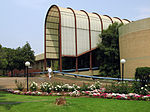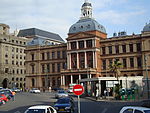Sacred Heart Cathedral, Pretoria
1877 establishments in Transvaal Colony19th-century Roman Catholic church buildings in South AfricaAfrican church stubsChurches in PretoriaRoman Catholic Archdiocese of Pretoria ... and 4 more
Roman Catholic cathedral stubsRoman Catholic cathedrals in South AfricaRoman Catholic churches completed in 1877South African building and structure stubs
The Cathedral of the Sacred Heart or just Pretoria Catholic Cathedral is a religious building belonging to the Catholic Church and is located in the Bosman street of the town of Pretoria, in Gauteng province in South Africa. The cathedral was built in 1877 in the Gothic architectural style, follows the Roman or Latin rite and serves as headquarters of the Metropolitan Archdiocese of Pretoria (Archidioecesis Praetoriensis) which was created in 1951 by the bull Suprema Nobis of Pope Pius XII. It has the dignity of cathedral since 1948.
Excerpt from the Wikipedia article Sacred Heart Cathedral, Pretoria (License: CC BY-SA 3.0, Authors).Sacred Heart Cathedral, Pretoria
Bosman Street, Pretoria Salvokop
Geographical coordinates (GPS) Address Website Nearby Places Show on map
Geographical coordinates (GPS)
| Latitude | Longitude |
|---|---|
| N -25.751409 ° | E 28.185829 ° |
Address
Sacred Heart Cath. Cathedral
Bosman Street
0126 Pretoria, Salvokop
Gauteng, South Africa
Open on Google Maps







